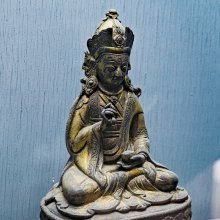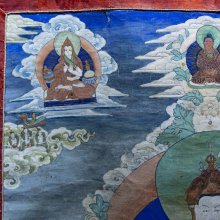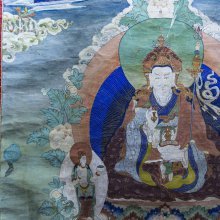Shambhava, Sambhava, Sambhavā, Śāmbhava, Saṃbhava: 37 definitions
Introduction:
Shambhava means something in Buddhism, Pali, Hinduism, Sanskrit, Jainism, Prakrit, Marathi, Hindi, biology. If you want to know the exact meaning, history, etymology or English translation of this term then check out the descriptions on this page. Add your comment or reference to a book if you want to contribute to this summary article.
The Sanskrit term Śāmbhava can be transliterated into English as Sambhava or Shambhava, using the IAST transliteration scheme (?).
Alternative spellings of this word include Sambhav.
Images (photo gallery)
In Hinduism
Shaivism (Shaiva philosophy)
Source: Wisdom Library: Ṣaṭsāhasra-saṃhitāSambhavā (सम्भवा):—One of the twelve guṇas associated with Piṇḍa, the seventh seat of the Svādhiṣṭhāna-chakra. According to tantric sources such as the Śrīmatottara-tantra and the Gorakṣasaṃhitā (Kādiprakaraṇa), these twelve guṇas are represented as female deities. According to the Ṣaṭsāhasrasaṃhitā however, they are explained as particular syllables. They (e.g. Sambhavā) only seem to play an minor role with regard to the interpretation of the Devīcakra (first of five chakras, as taught in the Kubjikāmata-tantra).
Source: archive.org: Vijnana Bhairava or Divine ConsciousnessŚāmbhava (शाम्भव) refers to a category of dhāraṇās according to the Śaivāgamas. The term dhāraṇā refers to a particular way “concentrating the mind”, and can be seen as a means of attaining the ultimate truth.
Source: Shodhganga: Mantra-sādhana: Chapter One of the KakṣapuṭatantraŚāmbhava (शाम्भव) is the name of an Āgama or Tantra mentioned in the Kakṣapuṭatantra verse 1.5-7.—“At a previous time, when Pārvatī asked him, Śaṅkara told of the attainments of vidyā in the wide worldly life, in various ways. I observed each teaching taught also by the troops of Gods, Siddhas (those who have attained supernatural power), Munis (saints), Deśikas (spiritual teachers), and Sādhakas (tantric practicioners). They are [, for example]: Śāmbhava... I shall carefully extract all the above-mentioned āgamas, which are transmitted from mouth to mouth, like butter extracted from coagulated milk”.
Source: Manasa Taramgini: Skanda Sadbhava: A distinctive Kaumara Tantra?Saṃbhava (संभव) refers to one of the eighteen chapters of the Skandasadbhāvasaṃraha: an abbreviation of the larger Skandasadbhāva in 12000 verses having its narrative framework set in Kailāsa where Nandin and Māheśvara engage in a dialog regarding the present Śāstra.

Shaiva (शैव, śaiva) or Shaivism (śaivism) represents a tradition of Hinduism worshiping Shiva as the supreme being. Closely related to Shaktism, Shaiva literature includes a range of scriptures, including Tantras, while the root of this tradition may be traced back to the ancient Vedas.
Ayurveda (science of life)
Source: Wisdom Library: Āyurveda and botanyŚāmbhava (शाम्भव) is another name for Devadāru, which is a Sanskrit word referring to Cedrus deodara (Himalayan cedar), from the Pinaceae family. It is classified as a medicinal plant in the system of Āyurveda (science of Indian medicine) and is used throughout literature such as the Suśrutasaṃhita and the Carakasaṃhitā. The synonym was identified in the Rājanighaṇṭu (verses 12.28), which is a 13th century medicinal thesaurus.
Source: gurumukhi.ru: Ayurveda glossary of terms1) Sambhava (सम्भव):—[sambhavaḥ] Possibility ; feasibility
2) [sambhavaḥ] Source: Something from which another thing originates

Āyurveda (आयुर्वेद, ayurveda) is a branch of Indian science dealing with medicine, herbalism, taxology, anatomy, surgery, alchemy and related topics. Traditional practice of Āyurveda in ancient India dates back to at least the first millenium BC. Literature is commonly written in Sanskrit using various poetic metres.
Purana and Itihasa (epic history)
Source: archive.org: Puranic EncyclopediaSambhava (सम्भव).—A King of the Pūru dynasty, son of Ūrjā and father of Jarāsandha. (Agni Purāṇa, Chapter 278).
Source: archive.org: Shiva Purana - English TranslationSaṃbhava (संभव) refers to “being created”, according to the Śivapurāṇa 2.4.13 (“The birth of Gaṇeśa”).—Accordingly, as Brahmā said to Nārada: “[...] Thinking thus the Goddess (Pārvatī) created a person with all the characteristics, out of the dirt (mala-saṃbhava) from her body. He was spotless and handsome in every part of his body. He was huge in size and had all brilliance, strength and valour. She gave him various clothes and ornaments. She blessed him with benediction and said—‘You are my son. You are my own. I have none else to call my own’. [...]”.
Source: Cologne Digital Sanskrit Dictionaries: The Purana Index1a) Saṃbhava (संभव).—A son of Sarva.*
- * Matsya-purāṇa 50. 31.
1b) At the end of samhāra; impossible to be told in detail; also nisarga.*
- * Vāyu-purāṇa 61. 136-7.

The Purana (पुराण, purāṇas) refers to Sanskrit literature preserving ancient India’s vast cultural history, including historical legends, religious ceremonies, various arts and sciences. The eighteen mahapuranas total over 400,000 shlokas (metrical couplets) and date to at least several centuries BCE.
Vyakarana (Sanskrit grammar)
Source: Wikisource: A dictionary of Sanskrit grammarSaṃbhava (संभव).—Iit. possibility. The word is used in the general sense of the possibility of the application of a rule or of the occurrence of a rule; cf. विधिनियमसंभवे विधिरेव ज्यायान् (vidhiniyamasaṃbhave vidhireva jyāyān) .M. Bh. on VI, 4.49 Vart.; Pari. Sek. Pari. 100; cf. also असति संभवे बाधनं भवति । आस्ति च संभवो यदुभयं स्यात् । (asati saṃbhave bādhanaṃ bhavati | āsti ca saṃbhavo yadubhayaṃ syāt |) Siradeva Pari. 35.

Vyakarana (व्याकरण, vyākaraṇa) refers to Sanskrit grammar and represents one of the six additional sciences (vedanga) to be studied along with the Vedas. Vyakarana concerns itself with the rules of Sanskrit grammar and linguistic analysis in order to establish the correct context of words and sentences.
Shaktism (Shakta philosophy)
Source: Google Books: Manthanabhairavatantram1) Śāmbhava (शाम्भव) refers to “the highest form of the state attained by those who have taken Kaula initiation”, according to the Niruttaratantra (quoted by Woodroffe 1973: 241).—The lowest condition is the basic state of the fettered soul—paśu—that is accordingly called paśubhāva. In this state one should follow the basic rules and norms enjoined by the common, exoteric scriptures that derive their authority from the Vedas and the smṛtis. [...] The next state [i.e., bhāva] is attained by those who have taken Kaula initiation, the highest form of which is called Śāmbhava, reminding us of the form of initiation taught in the Kubjikā Tantras that preceded these schools. [...]
2) Śāmbhava (शाम्भव) or Śāmbhavājñā refers to the Command (ājñā) associated with Oḍḍiyāna, one of the eight Sacred Seats (pīṭha), according to the Yogakhaṇḍa (chapter 14) of the Manthānabhairavatantra, a vast sprawling work that belongs to a corpus of Tantric texts concerned with the worship of the goddess Kubjikā.

Shakta (शाक्त, śākta) or Shaktism (śāktism) represents a tradition of Hinduism where the Goddess (Devi) is revered and worshipped. Shakta literature includes a range of scriptures, including various Agamas and Tantras, although its roots may be traced back to the Vedas.
Shaiva philosophy
Source: Brill: Śaivism and the Tantric Traditions (philosophy)Saṃbhava (संभव) refers to the a “possibility (that the means of valid knowledge may be refuted)”, according to the Īśvarapratyabhijñāvivṛtivimarśinī 2.131.—Accordingly, “[This ascertainment] is successfully performed, i.e.,] it is devoid of the failure (apāya) [consisting in] the lack of a means of [valid] knowledge, and [it is devoid of] the possibility [that the means of valid knowledge] may be refuted (dūṣaṇa-saṃbhava)”.
-
Yoga (school of philosophy)
Source: ORA: Amanaska (king of all yogas): A Critical Edition and Annotated Translation by Jason BirchSambhava (सम्भव) refers to “(that which is) produced”, according to the Haṭhapradīpikā 3.90.—Accordingly, “Pure ashes, which were produced (sambhava) by burning cow-dung, [should first be] placed in water. After having sex in which Vajrolī Mudrā [was performed], the woman and man, who are sitting comfortably and have finished love making, [should] immediately smear their own bodies [with the ashes mixed with water]

Yoga is originally considered a branch of Hindu philosophy (astika), but both ancient and modern Yoga combine the physical, mental and spiritual. Yoga teaches various physical techniques also known as āsanas (postures), used for various purposes (eg., meditation, contemplation, relaxation).
In Buddhism
Theravada (major branch of Buddhism)
Source: Pali Kanon: Pali Proper Names1. Sambhava. One of the two chief disciples of Sikhi Buddha. D.ii.4; J.i.41; Bu.xxi.20; S.i.155.
2. Sambhava. The constant attendant of Revata Buddha. J.i.35; Bu.vi.21.
3. Sambhava. The constant attendant of Tissa Buddha. J.i.40, but see Samanga.
4. Sambhava. A Pacceka Buddha of thirty one kappas ago. Sappaka Thera, in a previous birth, was a Naga and held a lotus over him. ThagA.i.399.
5. Sambhava. The Bodhisatta, born as the son of Vidhura and brother of Sanjaya and Bhadrakara. See the Sambhava Jataka.
Theravāda is a major branch of Buddhism having the the Pali canon (tipitaka) as their canonical literature, which includes the vinaya-pitaka (monastic rules), the sutta-pitaka (Buddhist sermons) and the abhidhamma-pitaka (philosophy and psychology).
Tibetan Buddhism (Vajrayana or tantric Buddhism)
Source: OSU Press: Cakrasamvara SamadhiSambhava (सम्भव) refers to the “birth (of a flower)”, according to the Guru Mandala Worship (maṇḍalārcana) ritual often performed in combination with the Cakrasaṃvara Samādhi, which refers to the primary pūjā and sādhanā practice of Newah Mahāyāna-Vajrayāna Buddhists in Nepal.—Accordingly, “[...] Oṃ be successful in undertakings, have increase in wealth. Be nourished in the body, (and) have peace in the home. Oṃ homage to the holy king Puṣpaketu, Tathāgata, Arhat, Enlightened Buddha. In this manner. Oṃ flower, flower, great flower, Good flower, flower arisen, flower born (puṣpa-sambhava), flower strewn Svāhā! [...]”.

Tibetan Buddhism includes schools such as Nyingma, Kadampa, Kagyu and Gelug. Their primary canon of literature is divided in two broad categories: The Kangyur, which consists of Buddha’s words, and the Tengyur, which includes commentaries from various sources. Esotericism and tantra techniques (vajrayāna) are collected indepently.
In Jainism
General definition (in Jainism)
Source: Wisdom Library: JainismSambhava (सम्भव):—The third Tīrthaṅkara (Janism recognizes 24 such teachers or Siddhas). His name can also be spelled as Saṃbhava (संभव) and he is also known as Sambhavanātha (or Saṃbhavanātha). His colour is gold (kāñcana), according to Aparājitapṛcchā (221.5-7). His height is 400 dhanuṣa (a single dhanuṣa (or, ‘bow’) equals 6 ft), thus, roughly corresponding to 732 meters. His emblem, or symbol, is an Horse.
Sambhava’s father is Jitari and his mother is Senā according to Śvetāmbara but Suṣeṇā according to Digambara. It is an ancient Jain practice to worship the Tīrthaṅkara’s parents in various rites, such as the pratiṣṭhāvidhi, according to the Ācāradinakara (14th century work on Jain conduct written by Vardhamāna Sūri).
Source: archive.org: Trisastisalakapurusacaritra1) Sambhava (सम्भव) (also Śambhava) refers to the third of the twenty-four Tīrthaṅkaras praised in the first book (ādīśvara-caritra) [chapter 1] of Hemacandra’s 11th century Triṣaṣṭiśalākāpuruṣacaritra: an ancient Sanskrit epic poem narrating the history and legends of sixty-three illustrious persons in Jainism.—Accordingly, “[...] we worship the Arhats, who at all times and all places purify the people of the three worlds by their name, representation, substance, and actual existence. [...] May the words of the Lord of the World, Holy Sambhava, prevail at the time of his preaching—words that resemble rivers in the garden of all the souls who can attain emancipation”.
Sambhava is the son of Jitāri and Senā (Senādevī), according to chapter 3.1, “At daybreak King Jitāri held a great birth-festival in honor of the Arhat deserving the world, who had become his son. In every house, on every road, in every market, in the whole city a festival took place just as in the palace. While he was in embryo, rice was grown (sambhūta); and at that time the second ploughing (śambā) took place; so his father gave the name ‘Sambhava’ and also ‘Śambhava’ to the Lord”.
2) Sambhava (सम्भव) refers to one of the warriors fighting in Rāma’s army, according to the Jain Ramayana and chapter 7.7 [The killing of Rāvaṇa].—Accordingly, “[...] When the battle had been going on for a long time, the army of the Rākṣasas was broken by the Vānaras like a forest by winds. [...] Then Sugrīva and the others made seven walls with four gates around the two Rāghavas by means of a vidyā. [...] In the west Nīla, Samaraśīla, Durdhara, Manmatha, Jaya, Vijaya, and Sambhava stood. [...]. Making the two Kākutsthas in the center in this way, Sugrīva and the others, powerful, were devoted to watching, intent as yogis. [...].”.
Source: University of Cambridge: JainismSaṃbhava (संभव) refers to one of the 70 teachers mentioned in the Kharataragacchapaṭṭāvalī: a Sanskrit text listing the heads or pontiffs (sūri) of the Kharataragaccha, one of the most important Śvetāmbara monastic orders. The Kharatara-gaccha is especially rooted in Rajasthan. The text includes a narration of events in their lives (i.e., of Saṃbhava), and can thus be called a Kharataragacchapaṭṭāvalī
Source: The University of Sydney: A study of the Twelve ReflectionsSaṃbhava (संभव) refers to “birth”, according to the 11th century Jñānārṇava, a treatise on Jain Yoga in roughly 2200 Sanskrit verses composed by Śubhacandra.—Accordingly, “For this embodied soul there is not another companion in union and in separation, in birth (saṃbhava) or in death and at the time of pleasure and pain. This [one] performs action for wealth, a son, a wife, etc. [and] he experiences alone that which is the result of that [action] in the levels of the Śvabhra [hell], etc.”.
Synonyms: Janman, Sūti, Bhava, Jāti.

Jainism is an Indian religion of Dharma whose doctrine revolves around harmlessness (ahimsa) towards every living being. The two major branches (Digambara and Svetambara) of Jainism stimulate self-control (or, shramana, ‘self-reliance’) and spiritual development through a path of peace for the soul to progess to the ultimate goal.
Biology (plants and animals)
Source: Google Books: CRC World Dictionary (Regional names)Sambhava in India is the name of a plant defined with Amomum subulatum in various botanical sources. This page contains potential references in Ayurveda, modern medicine, and other folk traditions or local practices It has the synonym Cardamomum subulatum (Roxb.) Kuntze (among others).
Example references for further research on medicinal uses or toxicity (see latin names for full list):
· Flora Indica, or ‘Descriptions of Indian Plants’ (1820)
· Revisio Generum Plantarum (1891)
· Notes from the Royal Botanic Garden Edinburgh (1972)
If you are looking for specific details regarding Sambhava, for example diet and recipes, extract dosage, health benefits, pregnancy safety, side effects, chemical composition, have a look at these references.

This sections includes definitions from the five kingdoms of living things: Animals, Plants, Fungi, Protists and Monera. It will include both the official binomial nomenclature (scientific names usually in Latin) as well as regional spellings and variants.
Languages of India and abroad
Pali-English dictionary
Source: BuddhaSasana: Concise Pali-English Dictionarysambhava : (m.) origin; birth; production; semen virile.
Source: Sutta: The Pali Text Society's Pali-English DictionarySambhava, (saṃ+bhava) 1. origin, birth, production D. II, 107; S. III, 86; A. II, 10, 18; Sn. 724, 741 etc.; Dh. 161; J. I, 168; mātāpettikas° born from father and mother D. I, 34; DhsA. 306; natthi sambhavaṃ has not arisen Sn. 235.—2. semen virile J. V, 152; VI, 160; Miln. 124.

Pali is the language of the Tipiṭaka, which is the sacred canon of Theravāda Buddhism and contains much of the Buddha’s speech. Closeley related to Sanskrit, both languages are used interchangeably between religions.
Marathi-English dictionary
Source: DDSA: The Molesworth Marathi and English Dictionarysambhava (संभव).—m (S) Suitableness or reasonableness of being; hence possibility, probability, likelihood. 2 Connection and congruity as apprehended or apparent; apprehension or view of as possible, probable, or real. Ex. tikaḍacēṃ pāṇī havā kasēṃ āhē mhaṇūna tū jēvhāṃ vicāratōsa tēvhāṃ tū tikaḍē rahāyāsa jāṇāra asā malā sambhava hōtō. 3 Consistency, conformity, correspondence, co-aptation or adaptation, adequateness or agreeableness, appropriate connection or relation. 4 Birth, production, rising into being. Note. We may here, as we might under innumerable other words have done, direct the learner's attention to the two forms of grammatical composition which are constantly occurring,--the tatpuruṣa and the bahuvrīhi. rōgasambhava, kaphasambhava, pittasambhava, parjanyasambhava, ariṣṭasambhava, kēśasambhava, asthisambhava, utpātasambhava, puṇyasambhava, pāpasambhava, dōṣa-sukha-duḥkha-rāga-harṣa-santāpa &c.-sambhava (Production or birth of disease, phlegm, bile &c.) are instances of the first; padmasambhava, yōnisambhava, sūryasambhava, kāṣṭhasambhava, mṛtsambhava, tṛṇasambhava &c. (Produced from the lotus, womb, sun, wood, earth &c.) are instances of the second. Compounds of these kinds are, as it will readily be seen, incalculably useful; and they may be multiplied by the scholar absolutely without end. 5 S Mixing or mixture; combining or combination;--the act or the product of it.
Source: DDSA: The Aryabhusan school dictionary, Marathi-Englishsambhava (संभव).—m Probability, possibility, likeli- hood. Consistency, conformity. cor- respondence. Birth, production. In comp. as kaphasambhava, rōgasambhava Production of phlegm, disease padmasambhava, sūryasambhava Produced from the lotus, sun.
Marathi is an Indo-European language having over 70 million native speakers people in (predominantly) Maharashtra India. Marathi, like many other Indo-Aryan languages, evolved from early forms of Prakrit, which itself is a subset of Sanskrit, one of the most ancient languages of the world.
Sanskrit dictionary
Source: DDSA: The practical Sanskrit-English dictionaryŚāmbhava (शाम्भव).—a.
1) (-vī f.) [शम्भोरिदम् अण् (śambhoridam aṇ)] Belonging to Śiva; अत्तुं वाञ्छति शाम्भवो गणपतेराखुं क्षुधार्तः फणी (attuṃ vāñchati śāmbhavo gaṇapaterākhuṃ kṣudhārtaḥ phaṇī) Pañcatantra (Bombay) 1.159.
-vaḥ A worshipper of Śiva.
2) A son of Śiva.
3) Camphor.
4) Bdellium.
5) A kind of poison.
-vam The Devadāru tree.
--- OR ---
Saṃbhava (संभव).—1 Birth, production, springing up, arising, existence प्रियस्य सुहृदो यत्र मम तत्रैव संभवो भूयात् (priyasya suhṛdo yatra mama tatraiva saṃbhavo bhūyāt) Mālatīmādhava (Bombay) 9; मानुषीषु कथं वा स्यादस्य रूपस्य संभवः (mānuṣīṣu kathaṃ vā syādasya rūpasya saṃbhavaḥ) Ś.1.26; अन्नाद्भवन्ति भूतानि पर्जन्यादन्नसंभवः (annādbhavanti bhūtāni parjanyādannasaṃbhavaḥ) Bhagavadgītā (Bombay) 3.14; oft. at the end of comp. in this sense; अप्सरःसभवैषा (apsaraḥsabhavaiṣā) Ś.1.
2) Production and bringing up; यं मातापितरौ क्लेशं सहेते संभवे नृणाम् (yaṃ mātāpitarau kleśaṃ sahete saṃbhave nṛṇām) Manusmṛti 2.227; (see Kull. thereon).
3) Cause, origin, motive.
4) Mixing, union, combination.
5) Possibility; संयोगो हि वियोगस्य संसूचयति संभवम् (saṃyogo hi viyogasya saṃsūcayati saṃbhavam) Subhāṣ.
6) Compatibility, consistency.
7) Adaptation, appropriateness.
8) Agreement, conformity.
9) Capacity.
1) Equivalence (one of the Pramāṇas).
11) Acquaintance.
12) Loss, destruction.
13) (In rhet.) A possible case.
14) Cohabitation.
15) (pl.) Wealth, prosperity; स सर्वभयनिर्मुक्तः संभवानधितिष्ठति (sa sarvabhayanirmuktaḥ saṃbhavānadhitiṣṭhati) Mahābhārata (Bombay) 13.64.11.
16) Knowledge (vidyā); अन्यदेवाहुः संभवाद- न्यदाहुरसंभवात् (anyadevāhuḥ saṃbhavāda- nyadāhurasaṃbhavāt) Īśop.13.
17) Occurrence, appearance.
Derivable forms: saṃbhavaḥ (संभवः).
Source: Cologne Digital Sanskrit Dictionaries: Edgerton Buddhist Hybrid Sanskrit DictionarySaṃbhavā (संभवा).—name of the world (lokadhātu) of the former Buddha Mahābhijñājñānābhibhū: Saddharmapuṇḍarīka 156.4.
Source: Cologne Digital Sanskrit Dictionaries: Shabda-Sagara Sanskrit-English DictionaryŚāmbhava (शाम्भव).—m.
(-vaḥ) 1. A sort of poison. 2. A worshipper of Siva. 3. The son of Sambhu or Siva. 4. Camphor. n.
(-vaṃ) The Devadaru tree. f. (-vī) Parvati. E. śambhu a name of Siva, aṇ aff.
--- OR ---
Sambhava (सम्भव).—m.
(-vaḥ) 1. Cause, origin, motive. 2. Birth, production. 3. Mixing, union, combination. 4. Capacity, appropriateness, adaptation, the conformity of the receptacle to the thing received, or supporter to the thing supported. 5. Agreement, engagement. 6. Loss, destruction. 7. Acquaintance, intimacy. 8. Possibility. 9. Ability, adequacy. 10. Consistency, compatibility. 11. The third Jina of the present age. E. sam implying perfection or coexistence, bhū to be, ap aff.
Source: Cologne Digital Sanskrit Dictionaries: Benfey Sanskrit-English DictionaryŚāmbhava (शाम्भव).—i. e. śambhu + a, I. adj. Belonging to Śiva, [Pañcatantra] i. [distich] 175. Ii. m. 1. Śiva. 2. A worshipper of Śiva. 3. A sort of poison. Iii. f. vī, Pārvatī.
--- OR ---
Saṃbhava (संभव).—i. e. sam-bhū + a, m. 1. Mixing, union. 2. Adaptation, appropriateness. 3. Adequacy, ability. 4. Possibility. 5. Compatibility, consistency. 6. Agreement. 7. Acquaintance. 8. Destruction, loss. 9. Springing up, [Hitopadeśa] iv. [distich] 72; origin, [Mānavadharmaśāstra] 1, 116; birth, [Mālatīmādhava, (ed. Calc.)] 156, 6; [Pañcatantra] 263, 23; production, [Hitopadeśa] 16, 5, M.M. 10. Producing and rearing, [Mānavadharmaśāstra] 2, 227. 11. Cause, motive, [Pañcatantra] i. [distich] 328 (grahaṇa-, of taking, viz. the life of a dependent).
Source: Cologne Digital Sanskrit Dictionaries: Cappeller Sanskrit-English DictionaryŚaṃbhava (शंभव).—[adjective] = śaṃbhu [adjective]
--- OR ---
Śāṃbhava (शांभव).—[feminine] ī relating to Cambhu (Śiva).
--- OR ---
Saṃbhava (संभव).—(saṃbhava) [masculine] being together, union, cohabitation; finding room or being contained in ([locative]); birth, origin, source; cause, motive; happening, rising, appearance; being, existence, possibility. Often adj. originating in, sprung from, caused by, appearing in or at (—°).
Source: Cologne Digital Sanskrit Dictionaries: Monier-Williams Sanskrit-English Dictionary1) Śambhava (शम्भव):—[=śam-bhava] [from śam] a mfn. = śambhu, [Vājasaneyi-saṃhitā]
2) [v.s. ...] m. (with Jainas) Name of the third Arhat of the present Avasarpiṇī, [cf. Lexicographers, esp. such as amarasiṃha, halāyudha, hemacandra, etc.]
3) [=śam-bhava] b śam-bhaviṣṭha See under 2. śam, p. 1054, col. 2.
4) Śāmbhava (शाम्भव):—mf(ī)n. ([from] śam-bhu) coming or derived from Śiva, relating or belonging or sacred to him, [Kāvya literature; Kathāsaritsāgara]
5) m. (only [cf. Lexicographers, esp. such as amarasiṃha, halāyudha, hemacandra, etc.]) a worshipper of Śiva
6) a son of Śambhu
7) Sesbana Grandiflora
8) camphor
9) a sort of poison
10) bdellium
11) n. Pinus Deodora, [cf. Lexicographers, esp. such as amarasiṃha, halāyudha, hemacandra, etc.]
12) Sambhava (सम्भव):—[=sam-bhava] a etc. See p. 1179, col. 1.
13) [=sam-bhava] [from sam-bhū] b m. (or sam-bhava) (ifc. f(ā). ) being or coming together, meeting, union, intercourse ([especially] sexual int°, cohabitation), [Gobhila-śrāddha-kalpa]
14) [v.s. ...] finding room in, being contained in (ifc.= ‘contained in’), [Mahābhārata; Suśruta]
15) [v.s. ...] birth, production, origin, source, the being produced from ([ablative]; ifc. = ‘arisen or produced from, made of, grown in’), [Manu-smṛti; Mahābhārata] etc.
16) [v.s. ...] cause, reason, occasion (ifc.= ‘caused or occasioned by’), [ib.]
17) [v.s. ...] being brought about, occurrence, appearance (ifc. = ‘occurring’ or ‘appearing in’), [ib.]
18) [v.s. ...] being, existence, [Śvetāśvatara-upaniṣad; Mahābhārata] etc.
19) [v.s. ...] capacity, ability, possibility (ifc. ‘made possible by’; ena, ‘according to possibility’, ‘as possible’), [Mahābhārata; Mārkaṇḍeya-purāṇa; Sāhitya-darpaṇa]
20) [v.s. ...] (in [rhetoric]) a possible case, [Kuvalayānanda]
21) [v.s. ...] (in [philosophy]) equivalence (regarded as one of the Pramāṇas q.v.; illustrated by the equivalence between one shilling and pence), [Monier-Williams’ Sanskrit-English Dictionary]
22) [v.s. ...] agreement, conformity ([especially] of the receptacle with the thing received), [Horace H. Wilson]
23) [v.s. ...] compatibility, adequacy, [ib.]
24) [v.s. ...] acquaintance, intimacy, [ib.]
25) [v.s. ...] loss, destruction, [ib.]
26) [v.s. ...] (with Buddhists) Name of a world, [Saddharma-puṇḍarīka]
27) [v.s. ...] Name of a prince, [Viṣṇu-purāṇa]
28) [v.s. ...] of the third Arhat of the present Avasarpiṇī, [cf. Lexicographers, esp. such as amarasiṃha, halāyudha, hemacandra, etc.]
29) [v.s. ...] mf(ā)n. existing, being, [Pañcarātra]
Source: Cologne Digital Sanskrit Dictionaries: Yates Sanskrit-English Dictionary1) Śāmbhava (शाम्भव):—(vaḥ) 1. m. A sort of poison; worshipper of Shiva. f.
(-ī) Pārvatī.
2) Sambhava (सम्भव):—[sa-mbhava] (vaḥ) 1. m. Cause; birth; union; capacity; agreement; loss; acquaintance; possibility.
Source: DDSA: Paia-sadda-mahannavo; a comprehensive Prakrit Hindi dictionary (S)Saṃbhāva (संभाव) in the Sanskrit language is related to the Prakrit words: Āsaṃgha, Saṃbhava, Saṃbhāva.
[Sanskrit to German]
Sanskrit, also spelled संस्कृतम् (saṃskṛtam), is an ancient language of India commonly seen as the grandmother of the Indo-European language family (even English!). Closely allied with Prakrit and Pali, Sanskrit is more exhaustive in both grammar and terms and has the most extensive collection of literature in the world, greatly surpassing its sister-languages Greek and Latin.
Hindi dictionary
Source: DDSA: A practical Hindi-English dictionarySaṃbhava (संभव) [Also spelled sambhav]:—(a) possible; hence ~[tā] (nf).
...
Prakrit-English dictionary
Source: DDSA: Paia-sadda-mahannavo; a comprehensive Prakrit Hindi dictionary1) Saṃbhava (संभव) in the Prakrit language is related to the Sanskrit word: Saṃbhū.
2) Saṃbhava (संभव) also relates to the Sanskrit word: Saṃbhava.
3) Saṃbhāva (संभाव) also relates to the Sanskrit word: Saṃbhāva.
4) Saṃbhāva (संभाव) also relates to the Sanskrit word: Lubh.
Prakrit is an ancient language closely associated with both Pali and Sanskrit. Jain literature is often composed in this language or sub-dialects, such as the Agamas and their commentaries which are written in Ardhamagadhi and Maharashtri Prakrit. The earliest extant texts can be dated to as early as the 4th century BCE although core portions might be older.
Kannada-English dictionary
Source: Alar: Kannada-English corpusŚaṃbhava (ಶಂಭವ):—[noun] (jain.) the third of the twenty four jaina spiritual teachers.
--- OR ---
Śāṃbhava (ಶಾಂಭವ):—[adjective] relating to Śambhu (Śiva).
--- OR ---
Śāṃbhava (ಶಾಂಭವ):—
1) [noun] a Śaiva devotee.
2) [noun] a volatile, crystalline ketone, C10H16O, with a strong characteristic odor, derived from the wood of the camphor tree or synthetically from pinene; camphor.
3) [noun] a kind of poison.
4) [noun] the resin of the tree Ailanthus malabarica, used as incense.
5) [noun] oneness of a devotee with Śiva, a yogic accomplishment.
--- OR ---
Saṃbhava (ಸಂಭವ):—
1) [noun] the act of coming into existence; birth.
2) [noun] that which brings about an effect or result; a cause.
3) [noun] the quality or condition of being possible; possibility.
4) [noun] a bringing or coming togehter; union; association.
5) [noun] something made by mixing two or more substances together; a mixture.
6) [noun] the quality or fact of being equal; equality.
7) [noun] (phil.) the quality or state of being probable; likelihood, considered as a proof; probability.
--- OR ---
Saṃbhava (ಸಂಭವ):—[adjective] = ಸಂಭವನೀಯ [sambhavaniya]1.
Kannada is a Dravidian language (as opposed to the Indo-European language family) mainly spoken in the southwestern region of India.
Nepali dictionary
Source: unoes: Nepali-English DictionarySambhava (सम्भव):—n. birth; origin; adj. possible; probable; adv. probably; possibly;
Nepali is the primary language of the Nepalese people counting almost 20 million native speakers. The country of Nepal is situated in the Himalaya mountain range to the north of India.
See also (Relevant definitions)
Partial matches: Sam, Bhava, Cam, Ca, Sha.
Starts with: Shambhava Upaya, Shambhavadeva, Shambhavadipika, Shambhavaha, Shambhavajna, Shambhavajnavara, Shambhavakalpaduma, Shambhavamandala, Shambhavanandakalpa, Shambhavapada, Shambhavasamavesha, Shambhavasutra, Shambhavavastha, Shambhavavedha, Shambhavavesha.
Query error!
Full-text (+1530): Garbhasambhava, Mahasambhava, Atmasambhava, Asambhava, Kshetrasambhava, Carmasambhava, Khasambhava, Bhumisambhava, Agnisambhava, Candrasambhava, Kumarasambhava, Marusambhava, Padmasambhava, Gosambhava, Kumbhasambhava, Yathasambhava, Kulasambhava, Nagasambhava, Kacasambhava, Shambhavadipika.
Relevant text
Search found 154 books and stories containing Shambhava, Sa-mbhava, Śam-bhava, Sam-bhava, Sambhava, Sambhavā, Śāmbhava, Saṃbhava, Saṃbhavā, Śaṃbhava, Śāṃbhava, Śambhava, Saṃbhāva, Sambhāva, Sham-bhava; (plurals include: Shambhavas, mbhavas, bhavas, Sambhavas, Sambhavās, Śāmbhavas, Saṃbhavas, Saṃbhavās, Śaṃbhavas, Śāṃbhavas, Śambhavas, Saṃbhāvas, Sambhāvas). You can also click to the full overview containing English textual excerpts. Below are direct links for the most relevant articles:
Cidgaganacandrika (study) (by S. Mahalakshmi)
Verse 123 [Khecarī attains Śambhupada through Suṣumnā-nāḍi] < [Chapter 3 - Third Vimarśa]
Verse 300 [Śambhava-Śākta-Guru kramas] < [Chapter 4 - Fourth Vimarśa]
Verse 195 [Bimba and Pratibimba] < [Chapter 4 - Fourth Vimarśa]
Trishashti Shalaka Purusha Caritra (by Helen M. Johnson)
Part 7: Sambhava’s childhood < [Chapter I - Sambhavajinacaritra]
Part 17: Sambhava’s mokṣa (nirvāṇa, emancipation) < [Chapter I - Sambhavajinacaritra]
Part 9: Sambhava becomes king < [Chapter I - Sambhavajinacaritra]
Philosophy of Charaka-samhita (by Asokan. G)
Other sources of knowledge referred to in Carakasaṃhitā < [Chapter 6 - Source of Knowledge (pramāṇa)]
Dialectical terms [in Charaka philosophy] < [Chapter 7 - Logic and Dialectical Speculations]
Knowledge (pramāṇa) [in Charaka philosophy] < [Chapter 6 - Source of Knowledge (pramāṇa)]
Purana Laksana < [Purana, Volume 1, Part 2 (1960)]
Yajna-varaha—Some more Material < [Purana, Volume 6, Part 1 (1964)]
Svalpa Matsya-purana < [Purana, Volume 6, Part 1 (1964)]
Bhaktavijaya: Stories of Indian Saints (by Justin E. Abbott)
22.12: Lineage of the Nath sect < [Chapter 22 - Matsyendranath, Gorakhnath and Changdev]
Garga Samhita (English) (by Danavir Goswami)
Verse 6.1.26 < [Chapter 1 - Jarāsandha’s Defeat]
Verse 1.12.23 < [Chapter 12 - Description of Śrī Nanda’s Festival]
Verse 8.13.74 < [Chapter 13 - A Thousand Names of Lord Balarāma]




